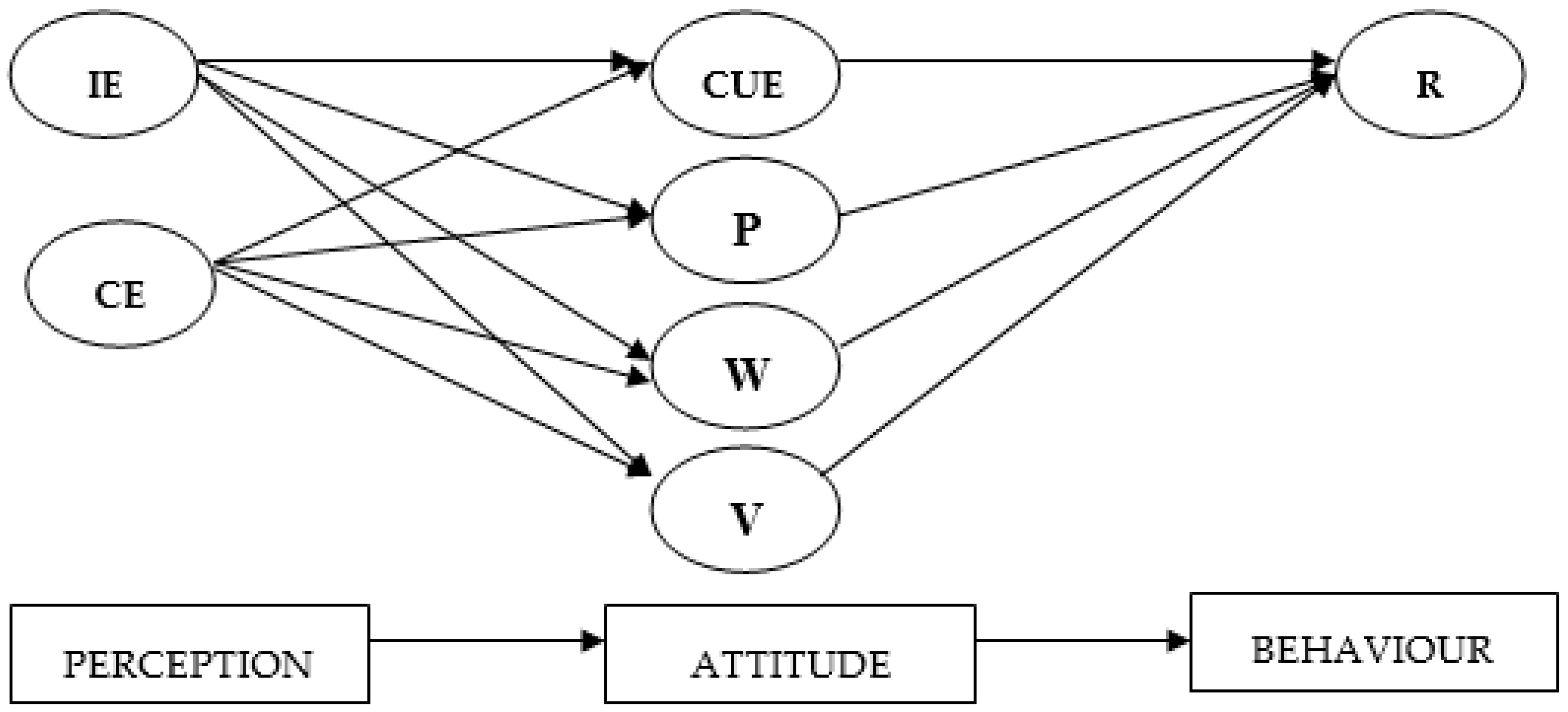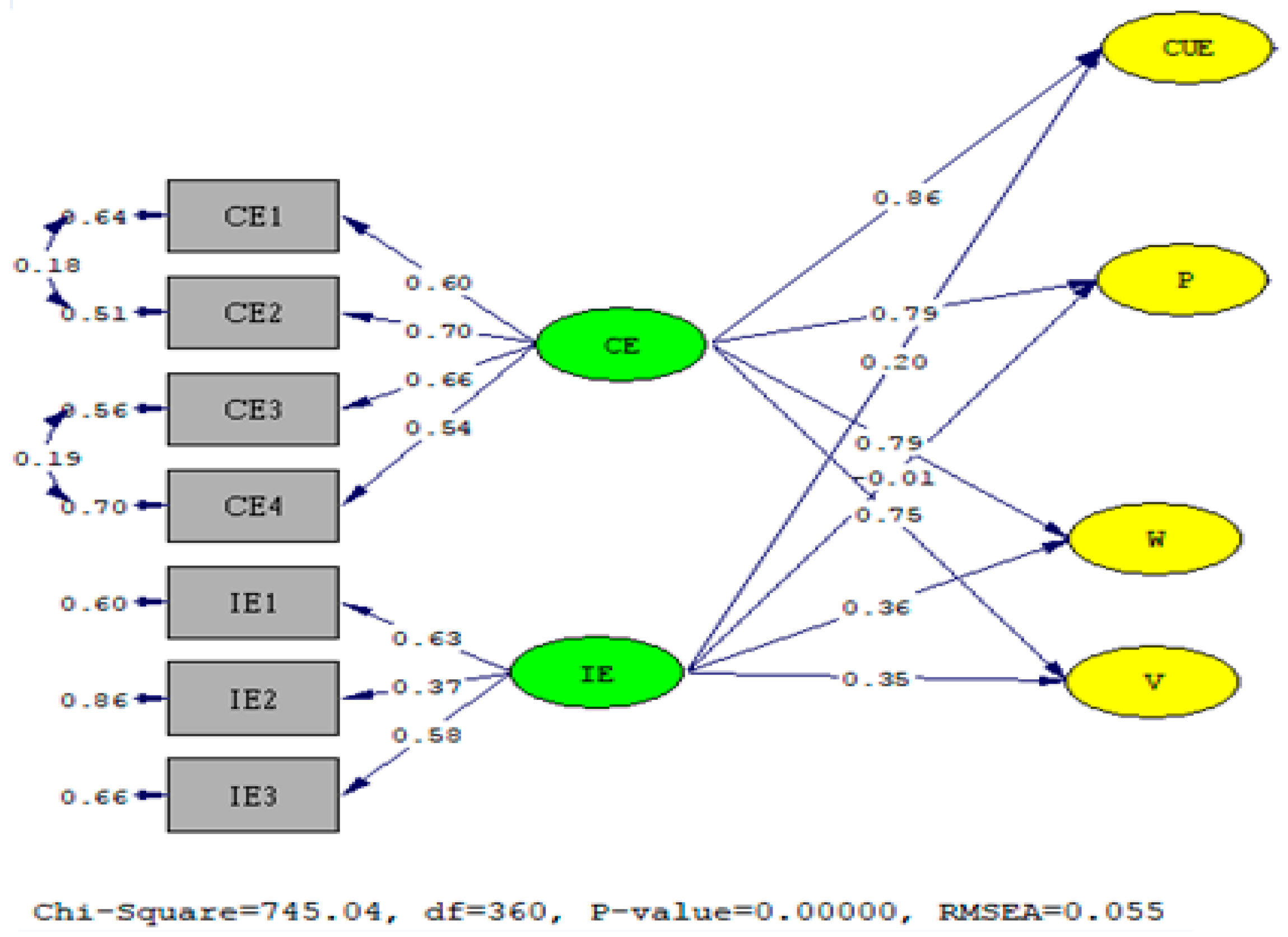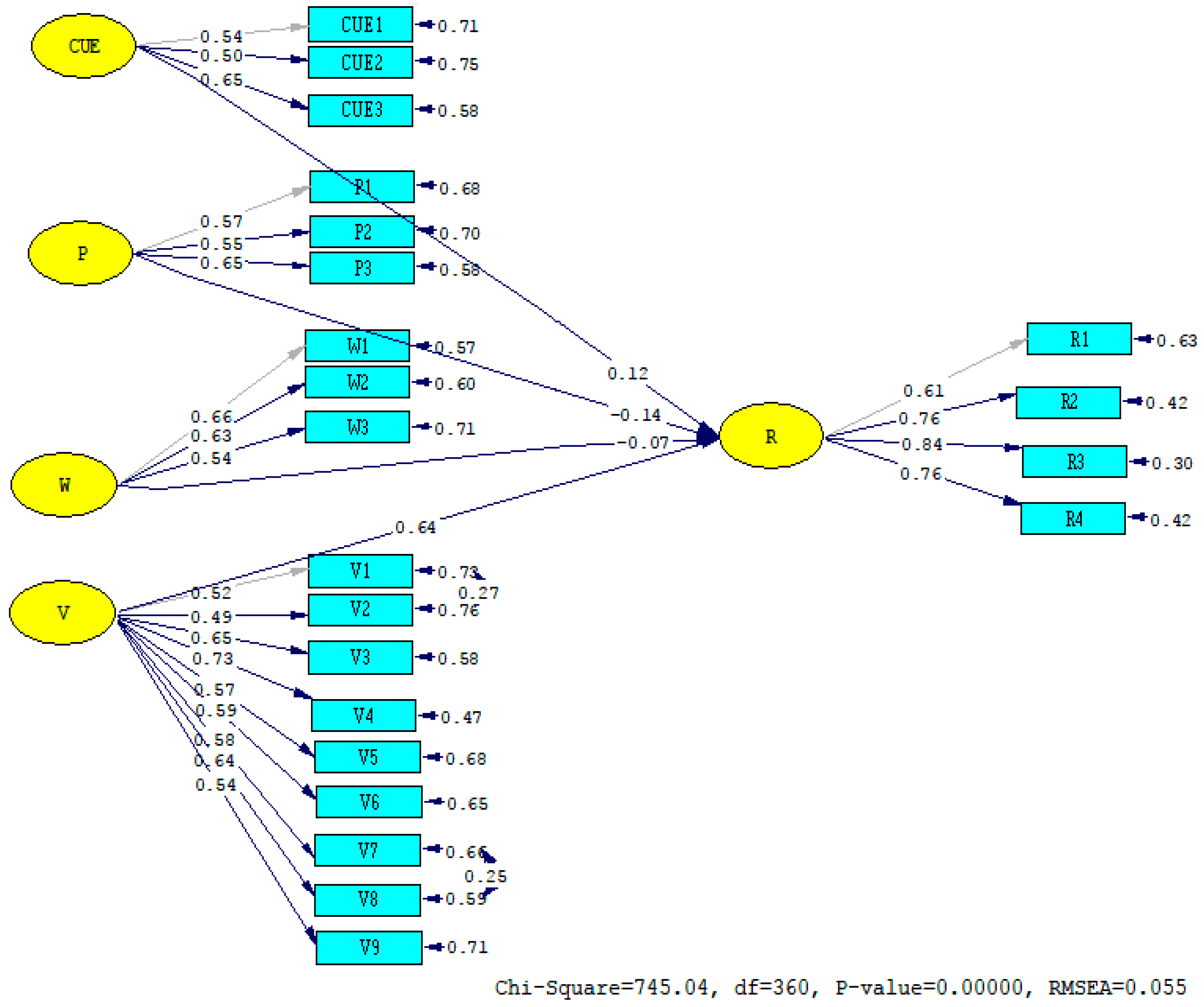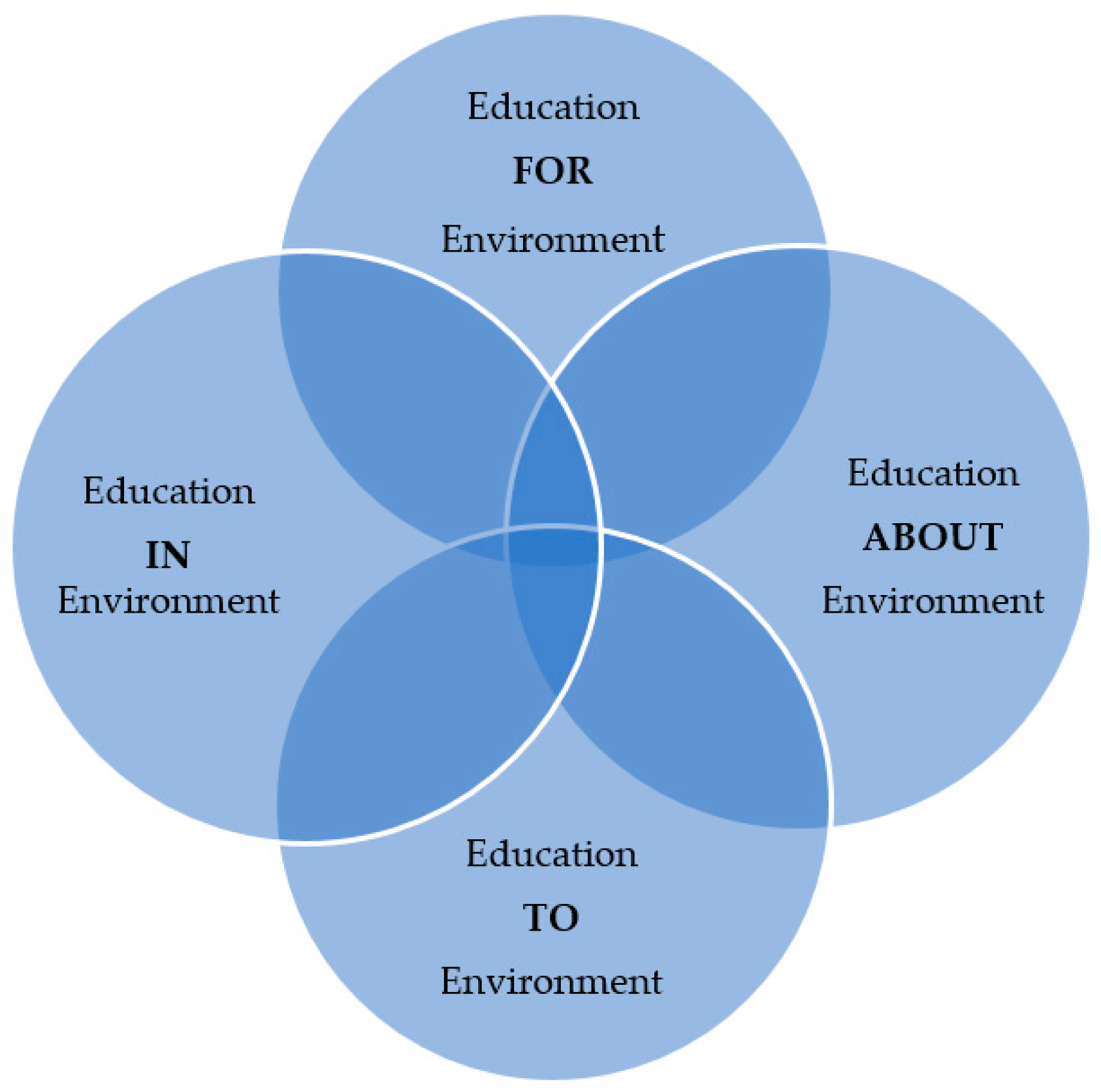Environmental Education and Student’s Perception, for Sustainability
Abstract
:1. Introduction
- Students represent a significant percentage of the young generation;
- Each country is vulnerable to disasters and degradations;
- The young generation, as new citizens, will inherit the responsibility of protecting the environment;
- They are already educated in and for the environment to be capable to educate others about the environment;
- They are the IT generation and fast communication and dissemination of information is their normal way of living.
Motivation of the Study
2. Materials and Methods
2.1. Sample and Measurement Tool
2.2. Purpose of the Study
- IE—importance of environment (IE1, IE2, and IE3);
- CE—concerns about environment (CE1, CE2, CE3, and CE4);
- CUE—culture environment (CUE1, CUE2, and CUE3);
- P—participation in different activities regarding environment;
- W—warning attitude regarding environment (W1, W2, and W3);
- V—volunteering activities, non-harmful actions (V1, V2, …, V9);
- R—reuse 3R’s (R1, R2, R3, and R4).
2.3. Reliability and Validity of Scales
3. Results
Correlations between Items
- Romanian students have a high score for environmental behavior (EB), especially for volunteer activities (V);
- they have culture regarding the environment CUE but they don’t like to be involved in direct activities like R reuse in a special place and special selection; they consider that there are paid personally for that;
- they are deeply involved in volunteer activities so they don’t like to be pushed or forced to do their citizen’s duty.
4. Conclusions
- Environmental education in Environment. Teaching institutions should adapt their curricula, cultivating a new type of education to induce students’ passion for environmental education using abilities and labs, and develop their service and practical exercises in nature, for example, learn about plants and the seasons’ influence on environment attitude and behavior activities of society, cleaning actions in parks, river, recycling the garbage from touristic roads, plant as practical lessons and the influence of different external factors of influence. Creativity can be used to create from garbage some state-of-the-art fashion, art painting, or design architecture.
- Environmental education for the Environment. Encouraging the students’ universities, which are considered as pillars and support in environmental education, to encourage the new citizen in different actions. Encourage students to create and keep their own shape of the internal environment (university campus) because the majority of their time is spent at school and it is their learning space. Therefore, they can use non-polluted energy, for example, solar and wind energy, they can use green letter.
- Environmental education about Environment. Deeper discussions to re-clarify, to criticize, and to compare some facts or attitudes towards nature and the environment; training about some specific situations and the solution taken to protect and preserve the environment for the future; a case study presentation and mass media presentation of disaster and solutions taken to prevent the situation, create an online group and volunteer activities between universities and a cross-cultural evaluation of environmental problems.
- Environmental education to Environment. Students can be encouraged to sustain their opinions, to respond to environmental problems in daily life, to express freely their opinions and personal ideas, to be involved in critical situations and to find solutions in limited situations. Here, we can use the online platforms to create the virtual environment and identify solutions or model some spaces or habitats for the risk situation and develop the ethics and effects upon the environment.
5. Future Research
Author Contributions
Conflicts of Interest
References
- Thomas, G. Facilitation in education for the environment. Aust. J. Environ. Educ. 2015, 21, 107–116. [Google Scholar] [CrossRef]
- UNESCO—UNEP. International Environmental Education Programme, Series 17. A Comparative Survey of the Incorporation of EE into School Curricula; UNESCO: Paris, France, 1985. [Google Scholar]
- UNESCO. International Strategy for Action in the Field of Environmental Education and Training for the 1990s; UNESCO: Nairobi, Kenya; Paris, France, 1987. [Google Scholar]
- Environmental Education and Sustainable Tourism Biplab Roy Bangladesh. Available online: https://archive.org/stream/Httpwww.iaset.usview_archives.phpyear2015jtype2id32detailsarchives_20150729/7.%20IJBGM%20-%20Environmental%20Education%20and%20Sustainable%20Tourism%20-%20Biplab%20Roy%20-%20Bangladesh_djvu.txt (accessed on 19 January 2019).
- UNESCO-UNEP. The Tbilisi Declaration Connect; UNESCO-UNEP: Paris, France, 1977. [Google Scholar]
- UNESCO-UNEP. Education for Sustainable Development; UNESCO-UNEP: Paris, France, 1996. [Google Scholar]
- UNESCO. L’education Relative a l’Environnement: Principes D’eisegnement et D’apprentissage: Programme International; UNESCO: Paris, France, 2011. [Google Scholar]
- Crohn, K.; Birbaum, M. Environmental education evaluation: Time to reflect, time for change. Eval. Program Plan. 2010, 33, 155–158. [Google Scholar] [CrossRef] [PubMed]
- Environmental Education Evaluation. Time to Reflect Time for Change. Available online: https://www.researchgate.net/publication/223590054_Environmental_education_evaluation_Time_to_reflect_time_for_change (accessed on 19 February 2019).
- Liu, S.; Guo, L. Based on Environmental Education to Study the Correlation between Environmental Knowledge and Environmental Value. Eurasia J. Math. Sci. Technol. Educ. 2018, 14, 3311–3319. [Google Scholar] [CrossRef]
- Dunlap, R.E.; Gallup, G.; Gallup, A. Global environmental concern: Results from an international public opinion survey. Environment 1993, 35, 33–39. [Google Scholar]
- Dunlap, R.E.; Gallup, G.; Gallup, A. Health of the Planet: Results of a 1992 International Environmental Opinion Survey of Citizens in 24 Countries; The George H. Gallup International Institute: Princeton, NJ, USA, 1992. [Google Scholar]
- Riordan, M.; Klein, E.J. Environmental Education in Action: How Expeditionary Learning Schools Support Classroom Teachers in Tackling Issues of Sustainability. Teach. Educ. Q. 2010, 37, 119–134. [Google Scholar]
- Environmental Awareness in Youth. Available online: https://mafiadoc.com/environmental-awareness-in-youthpdf-pdf-download-available_59984af41723dd94bda86570.html (accessed on 19 February 2019).
- Education Increases-Awareness and Concern for the Environment. Available online: https://gemreportunesco.wordpress.com/2015/12/08/education-increases-awareness-and-concern-for-the-environment/ (accessed on 19 February 2019).
- Schultz, P. Environmental Attitudes and Behaviors Across Cultures. Online Read. Psychol. Cult. 2002. [Google Scholar] [CrossRef]
- European Commission. Attitudes of European Citizens towards the Environment. Special Euro Barometer 2008. Available online: http://ec.europa.eu/public opinion/ archives/ebs 295 en.pdf (accessed on 19 February 2019).
- Nistor, L. Sociologia Mediului Înconjurător. Aplicaţii Privind Atitudini şi Comportamente în România; Presa Universitară Clujeană: Cluj-Napoca, Romania, 2009. [Google Scholar]
- Atitudinea Romanilor si Europenilor Fata de Mediu. Available online: https://alinangheluta.ro/2013/01/08/atitudinea-romanilor-si-europenilor-fata-de-mediu/ (accessed on 20 February 2019).
- Sauvé, L. Sustainable Development: A Further Appraisal. Can. J. Environ. Educ. 1997. Available online: https://www.researchgate.net/publication/264870000 (accessed on 19 February 2019).
- Global Concern for the Environment: Is Affluence a Prerequisite? Available online: https://spssi.onlinelibrary.wiley.com/doi/pdf/10.1111/j.1540-4560.1995.tb01351.x#accessDenialLayout (accessed on 19 January 2019).
- Kelly, B.; Martha, M.; Foundation of Environmental Education. Across the Spectrum: Resources for Environmental Educators; Martha, M., Marianne, K., Eds.; North American Association of Environmental Education: Washington, DC, USA, 2013. [Google Scholar]
- Jadhav, A.S.; Jadhav, V.V.; Raut, P. Role of Higher Education Institutions in Environmental Conservation and Sustainable Development: A case study of Shivaji University, Maharashtra, India. J. Environ. Earth Sci. 2014, 4, 17–29. [Google Scholar]
- Foundation of Environmental Education. Available online: https://www.researchgate.net/publication/257921015 (accessed on 19 February 2019).
- Beringer, A.; Malone, L.; Wright, T. Sustainability in Higher Education. Int. J. Sustain. High. Educ. 2006, 9, 48–66. [Google Scholar] [CrossRef]
- Arjen, E.; Wals, J. Learning Our Way Out of Unsustainability: The Role of Environmental Education. In The Oxford Handbook of Environmental and Conservation Psychology; OUP: Oxford, UK, 2012. [Google Scholar]
- Environmental Education and Sustainable Tourism a Model to Fit the Tourism Growth in Cox’s Bazaar, International Journal of Business and General Management (IJBGM). 2015. Available online: https://www.researchgate.net/publication/317033044_ENVIRONMENTAL_EDUCATION_AND_SUSTAINABLE_TOURISM_A_MODEL_TO_FIT_THE_TOURISM_GROWTH_IN_COX’S_BAZAR (accessed on 19 January 2019).
- Akinci, Z.; Yurcu, G.; Kasalak, M.A. Role of Perception in the Relationship between Expectation and Satisfaction in Terms of Sustainability in Tourism Education. Sustainability 2018, 10, 2253. [Google Scholar] [CrossRef]
- Zsóka, A.; Szerényi, Z.; Széchy, A.; Kocsis, T. Greening due to environmental education? Environmental knowledge, attitudes, consumer behavior and everyday pro-environmental activities of Hungarian high school and university students. J. Clean. Prod. 2013, 48, 126–138. [Google Scholar] [CrossRef]
- Environmental Management Practices in the Manufacturing Sector—Hungarian Features in International Comparison. Available online: https://www.researchgate.net/publication/227486820_Environmental_management_practices_in_the_manufacturing_sector_-_Hungarian_features_in_international_comparison (accessed on 19 February 2019).
- Moyo, N.; Masuku, I. Based on Environmental Education: The Effects of Environmental Knowledge and Awarness on the Purchase Intention of New Energy vehicles in the Southern part of China. Adv. Soc. Sci. Res. 2018. [Google Scholar] [CrossRef]
- Environment Initiates. Available online: http://www.ci.richmond.ca.us/1610/Environmental-Initiatives (accessed on 20 February 2019).
- Abdullah, A.; Zakaria, S.Z.S.; Razman, M.R. Environmental Education through Outdoor Education for Primary School Children. Int. J. Malay World Civ. 2018, 6, 27–34. [Google Scholar]
- Dyment, J.E. Green School grounds as sites for outdoor learning: Barriers and opportunities. Int. Res. Geogr. Environ. Educ. 2005, 14, 28–45. [Google Scholar] [CrossRef]
- Rickinson, M.; Dillon, J.; Teamey, K.; Morris, M.; Choi, M.Y.; Sanders, D.; Benefield, P. A Review of Research on Outdoor Learning; Field Studies Council: Shropshire, UK, 2004. [Google Scholar]
- Bell, A.C.; Dyment, J.E. Grounds for Action: Promoting Physical Activity through School Ground Greening in Canada; Evergreen: Toronto, ON, Canada, 2006. [Google Scholar]
- Pandit, R.; Dhakal, M.; Polyakov, M. Valuing access to protected areas in Nepal: The case of Chitwan National Park. Tour. Manag. Eurasia J. Math. Sci. Tech. Ed. 2015. [Google Scholar] [CrossRef]
- Ugolini, F.; Massetti, L.; Pellegrino, L.; Rossini, G. Environmental Education by Gaming. Available online: https://www.researchgate.net/publication/309577365_Environmental_education_by_gaming (accessed on 24 February 2019).
- Test of Innovative Environmental Education Methodologies in Tuscany. Available online: https://www.researchgate.net/scientific-contributions/2039720821_L_Pellegrino (accessed on 20 January 2019).
- Ardoin, N.M.; DiGiano, M.; Bundy, J.; Chang, S.; Holthuis, N.; O’Connor, K. Using digital photography and journaling in evaluation of field-based environmental education programs. Stud. Educ. Eval. 2014, 41, 68–76. [Google Scholar] [CrossRef]
- Elnashaie, S.S.E. Environmental Engineering and Sustainable Development. Eur. J. Sustain. Dev. Res. 2018, 2, 11. [Google Scholar] [CrossRef]
- Liu, Q.; Gong, D.; Chen, M. Applying Virtual Reality to Study the Effects of Environmental Education on College Students’ Ethics and Environmental Literacy. Eurasia J. Math. Sci. Tech. Ed. 2018. [Google Scholar] [CrossRef]
- Lucas, A.M. Environment and Environmental Education: Conceptual Issues and Curriculum Implications. Ph.D. Thesis, Ohio State University, Columbus, OH, USA, 1972. [Google Scholar]
- Environment and Environmental Education: Conceptual Issues and Curriculum Implications. Available online: https://www.researchgate.net/publication/36112785_Environment_and_environmental_education_conceptual_issues_and_curriculum_implications (accessed on 19 January 2019).
- Scott, W.; Vare, P. The World We’ll Leave Behind; Routledge: London, UK, 2018. [Google Scholar]
- Franzen, R.E. Environmental education in teacher education programs: Incorporation and use of professional guidelines. J. Sustain. Educ. Available online: http://www.susted.com/wordpress/content/environmental-education-in-teacher-education-programs-incorporation-and-use-of-professional-guidelines_2018_01/comment-page-1/ (accessed on 19 January 2019).
- Understanding Environmental Education in Secondary Schools of England, School of Environmental Education & Society, Environmental Education Research Group, King’s College London Perspective from Policy, Report 1/2018. British Academy. Available online: https://www.kcl.ac.uk/sspp/departments/education/research/research-centres/crestem/research/current-projects/understanding-environmental-education-in-secondary-schools (accessed on 19 January 2019).
- Paredes Chi, A.A.; Viga de Alva, M.D. Environmental education EE policy and content of the contemporary (2009–2017) Mexican national curriculum for primary schools. Environ. Educ. Res. 2018. [Google Scholar] [CrossRef]
- Aikens, K.; McKenzie MVaughter, P. Environmental and sustainability education policy research: A systematic review of methodological and thematic trends. Environ. Educ. Res. 2016, 22, 333–359. [Google Scholar] [CrossRef]
- Ramirez, R.I.S. Student Leadership Role for Environmental protection. Pac. J. Multidiscip. Res. 2017, 5, 204–211. [Google Scholar]
- Spira, F. Driving the Energy Transition at Maastricht University? Analyzing the Transformative Potential on Energy Efficiency of the Student-Driven and Staff Supported Maastricht University Green Office; University College London: London, UK, 2013/13. [Google Scholar]
- Levin, B. Putting students at the center of education reform. J. Educ. Chang. 2000, 1, 155–172. [Google Scholar] [CrossRef]
- Center for Sustainable Energy and Environmental Engineering. Available online: http://www.ecu.edu/cs-cet/sustainability/ (accessed on 20 January 2019).
- Wallner, E. Accelerating Universities Focus on Sustainable Development through Student Involvement; Chalmers University of Technology: Gothenburg, Sweden, 2005. [Google Scholar]
- Tourist Environmental Education in Wetland Reserves: A Case Study of the Red- Crowned Cranes and David’s Deer National Reserves in Yancheng, China. Available online: http://www.ecologica.cn/stxb/ch/html/2015/23/stxb201404290856.htm (accessed on 21 January 2019).
- Proiect Privind Grija Fata de Mediul Inconjurator. Available online: http://jurnalmm.ro/proiect-privind-grija-fata-de-mediul-inconjurator/ (accessed on 21 January 2019).
- Garda Nationala de Mediu. Available online: https://www.gnm.ro/ (accessed on 21 January 2019).
- Saraçlı, S.; Yılmaz, V.; Arslan, T. The effects of mothers’ educational levels on university students’ environmental protection commitments and environmental behaviors. Eurasian J. Educ. Res. 2014, 55, 177–200. [Google Scholar] [CrossRef]
- Schermelleh-Engel, K.; Moosbrugger, H.; Müller, H. Evaluating the Fit of Structural Equation Models: Tests of Significance and Descriptive Goodness-of-Fit Measures. Methods Psychol. Res. 2003, 8, 23–74. [Google Scholar]




| H1 | Perceptions of the students about the importance of environment have a significant effect on their attitudes about their culture. |
| H2 | Perceptions of the students about the importance of environment have a significant effect on their attitudes about their participation. |
| H3 | Perceptions of the students about the importance of environment have a significant effect on their attitudes about their warning. |
| H4 | Perceptions of the students about the importance of environment have a significant effect on their attitudes about their volunteer. |
| H5 | Perceptions of the students about the concern of environment have a significant effect on their attitudes about their culture. |
| H6 | Perceptions of the students about the concern of environment have a significant effect on their attitudes about their participation. |
| H7 | Perceptions of the students about the concern of environment have a significant effect on their attitudes about their warning. |
| H8 | Perceptions of the students about the concern of environment have a significant effect on their attitudes about their volunteer. |
| H9 | Attitudes of students for Culture have a significant effect on their Reuse behavior. |
| H10 | Attitudes of students for Participation have a significant effect on their Reuse behavior. |
| H11 | Attitudes of students for Warning have a significant effect on their Reuse behavior. |
| H12 | Attitudes of students for Volunteer Perspective have a significant effect on their Reuse behavior. |
| Hypotheses | Paths | Standardized Parameter Estimate Values | t Values | Results |
|---|---|---|---|---|
| H1 | (IE)→(CUE) | 0.19 | 2.36 | Confirmed |
| H2 | (IE)→(P) | 0.02 | −0.20 | Not Confirmed |
| H3 | (IE)→(W) | 0.36 | 4.46 | Confirmed |
| H4 | (IE)→(V) | 0.36 | 4.74 | Confirmed |
| H5 | (CE)→(CUE) | 0.85 | 8.34 | Confirmed |
| H6 | (CE)→(P) | 0.79 | 8.39 | Confirmed |
| H7 | (CE)→(W) | 0.79 | 9.49 | Confirmed |
| H8 | (CE)→(V) | 0.74 | 8.48 | Confirmed |
| H9 | (CUE)→(R) | 0.17 | 1.28 | Not Confirmed |
| H10 | (P)→(R) | −0.13 | −1.24 | Not Confirmed |
| H11 | (W)→(R) | −0.03 | −0.26 | Not Confirmed |
| H12 | (V)→(R) | 0.53 | 4.96 | Confirmed |
| Criteria | Perfect Fitness | Acceptable Fitness | Model |
|---|---|---|---|
| RMSEA | 0 < RMSEA < 0.05 | 0.05 ≤ RMSEA ≤ 0.10 | 0.055 |
| NFI | 0.95 ≤ NFI ≤ 1 | 0.90 ≤ NFI ≤ 0.95 | 0.92 |
| NNFI | 0.97 ≤ NNFI ≤ 1 | 0.95 ≤ NNFI ≤ 0.97 | 0.95 |
| CFI | 0.97 ≤ CFI ≤ 1 | 0.95 ≤ CFI ≤ 0.97 | 0.95 |
| GFI | 0.95 ≤ GFI ≤ 1 | 0.90 ≤ GFI ≤ 0.95 | 0.87 |
| AGFI | 0.90 ≤ AGFI ≤ 1 | 0.85 ≤ AGFI ≤ 0.90 | 0.85 |
| Factors | Loadings | Eigen Values | % of Variance | α | |
|---|---|---|---|---|---|
| IE | Importance of the Environment | 1.061 | 6.117 | 0.547 | |
| IE1 | I believe environmental issues are being exaggerated | 0.734 | |||
| IE2 | I never have serious concerns about issues like water I never have serious concerns about issues like marine pollution | 0.688 | |||
| IE3 | I don’t believe that the extinction of animals and plants will destroy the World | 0.618 | |||
| CE | Concern about the Environment | 1.806 | 9.353 | 0.788 | |
| CE1 | I am concerned about the effects of air pollution on my family I am concerned about effects of air pollution on me | 0.795 | |||
| CE2 | It’s annoys me to see that factory wastes cause environment pollution | 0.725 | |||
| CE3 | Environmental pollution worries me | 0.726 | |||
| CE4 | I am afraid that environmental pollution will make the world an uninhabitable place | 0.615 | |||
| CUE | Culture Environment | 1.138 | 6.307 | 0.601 | |
| CUE1 | I will check and switch off unnecessarily used lights | 0.786 | |||
| CUE2 | I will use the back of papers when I am studying | 0.757 | |||
| CUE3 | I will warn those polluting the nature | 0.388 | |||
| P | Participation | 1.212 | 6.630 | 0.616 | |
| P1 | I will not directly and indirectly harm environment with economic concerns in my business and private life | 0.803 | |||
| P2 | I will show no violence and aggression towards the environment I live in and what is inside it | 0.570 | |||
| P3 | I will do my best to make the environment I live in more livable | 0.547 |
| Factors | Loadings | Eigen Values | % of Variance | α | |
|---|---|---|---|---|---|
| V | Volunteer | 7.159 | 12.692 | 0.831 | |
| V1 | I will be an actively involved member of nature and environmental organizations like mention it | 0.730 | |||
| V2 | I will work on a voluntary basis for nature and human beings | 0.718 | |||
| V3 | I will take part in tree-planting activities | 0.660 | |||
| V4 | I will take part in environmental cleaning campaigns | 0.658 | |||
| V5 | I will take action on nature polluters with the local authorities | 0.599 | |||
| V6 | I will set aside the wastes of products consumed for recycling | 0.600 | |||
| V7 | I will use products produced from non-renewable resources like underground oil, coal, natural gas, and mines in an economical manner because we will be unable to replace them with new resources | 0.445 | |||
| V8 | I will make noun necessary consumption to make sure pollution is eliminated at its source | 0.444 |
| Factors | Loadings | Eigen Values | % of Variance | α | |
|---|---|---|---|---|---|
| W | Warning | 1.505 | 6.679 | 0.627 | |
| W1 | I will warn those harming trees and flowers in parks and gardens | 0.744 | |||
| W2 | I will warn those in my immediate vicinity to refrain from any unnecessary consumption | 0.709 | |||
| W3 | I will fight those endangering the nature | 0.532 |
| Factors | Loadings | Eigen Values | % of Variance | α | |
|---|---|---|---|---|---|
| R | Reuse | 2.534 | 10.846 | 0.829 | |
| R1 | I am buying ecological products although they are more expensive | 0.833 | |||
| R2 | I am buying products with recyclable packaging | 0.825 | |||
| R3 | I am buying the products of companies backing environmental projects | 0.742 | |||
| R4 | I prefer using products produced from renewable raw materials | 0.701 |
| Factors | Mean | Std. Dev. | |
|---|---|---|---|
| IE | Importance of Environment | 3.1899 | 0.94639 |
| CE | Concern about Environment | 4.2102 | 0.60662 |
| CUE | Culture Environment | 4.1806 | 0.56698 |
| P | Participation | 4.3454 | 0.53931 |
| V | Volunteer | 3.8994 | 0.59601 |
| W | Warning | 4.1490 | 0.64205 |
| R (Behavior) | Reuse | 3.4839 | 0.82942 |
| Perception | 3.7001 | 0.54471 | |
| Attitude | 4.1436 | 0.43513 |
© 2019 by the authors. Licensee MDPI, Basel, Switzerland. This article is an open access article distributed under the terms and conditions of the Creative Commons Attribution (CC BY) license (http://creativecommons.org/licenses/by/4.0/).
Share and Cite
Boca, G.D.; Saraçlı, S. Environmental Education and Student’s Perception, for Sustainability. Sustainability 2019, 11, 1553. https://doi.org/10.3390/su11061553
Boca GD, Saraçlı S. Environmental Education and Student’s Perception, for Sustainability. Sustainability. 2019; 11(6):1553. https://doi.org/10.3390/su11061553
Chicago/Turabian StyleBoca, Gratiela Dana, and Sinan Saraçlı. 2019. "Environmental Education and Student’s Perception, for Sustainability" Sustainability 11, no. 6: 1553. https://doi.org/10.3390/su11061553
APA StyleBoca, G. D., & Saraçlı, S. (2019). Environmental Education and Student’s Perception, for Sustainability. Sustainability, 11(6), 1553. https://doi.org/10.3390/su11061553





